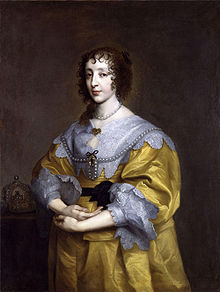Henrietta Maria of France
Henrietta Maria (* 15. November 1609 in Paris ; † 10. September 1669 in Castle Colombes ) was through her marriage to Charles I of 13 June 1625 until 30 January 1649 Queen of England , Scotland and Ireland .
origin
As Henrietta-Marie de Bourbon, the youngest daughter of Henry IV of France and Maria de Medici and sister of the future King Louis XIII. , she lost her father in an assassination attempt in the first year of life ; her mother, in whose care she now grew up, was banned from the French court in 1617 for reasons of state .
marriage
From dynastic married considerations, she was a Catholic - her father was converted to the religious wars to end between the aristocratic parties in France - an unpopular choice for an English king. She was married to him in early May 1625 by diplomatic means by deputy shortly after his enthronement . The actual wedding took place on June 13, 1625 in the Catholic Church of St. Augustine in Canterbury , because their denomination made a wedding according to the Anglican rite impossible. The relationship was initially determined by cold feelings. Originally, Charles had intended to be a daughter of the Spanish King Philip III. to marry, but a diplomatic mission to that effect had failed. Their French origins and their Catholic faith initially made them very unpopular in England.
She did not get along at all with the king's favorite, George Villiers, 1st Duke of Buckingham . When his killer, John Felton , was persecuted in August 1628, this put their relationship with the king to the test again. Nevertheless, the relationship between the couple eventually improved. In the English royal court it was said that the king was beginning to fall in love with the queen.
Her refusal to renounce Catholicism alienated her from the population and from influential advisers to her husband such as William Laud , Archbishop of Canterbury and Thomas Wentworth , Earl of Strafford . Henrietta Maria became the mother of ten children, six of whom reached adulthood, and suffered multiple miscarriages .
progeny
- Karl Jakob (* / † May 13, 1629), Duke of Cornwall and Rothesay
- Charles II (born May 29, 1630, † February 6, 1685)
- Maria (November 4, 1631 - December 24, 1660) ∞ Willem II of Orange
- Jacob II (October 14, 1633 - September 16, 1701)
- Elisabeth (December 29, 1635 - September 8, 1650)
- Anne (March 17, 1637, † November 5, 1640)
- Catherine (* / † June 29, 1639)
- Henry (8 July 1640 - 13 September 1660), Duke of Gloucester
- Henriette Anne (June 16, 1644 - June 30, 1670) ∞ Philippe d'Orléans
Struggle for domestic power
When domestic political conflicts emerged in the 1630s, Henrietta Maria turned increasingly to national politics. She created an alliance with the Puritan courtiers to prevent rapprochement with Spain and planned a coup d'état to disempower parliament . However, their clearly Catholic-oriented relationships with the Pope and France reduced Karl's chances of success and angered the population.
Civil war
When the civil war began in August 1642 , Henriette Marie was on the continent in the Netherlands, where she raised funds for the royalist party. She did not return to England until the beginning of 1643. She landed with her companions in Bridlington ( Yorkshire ) and tried hard to organize support for the royalists in northern England. The collapse of the royal positions and the monarch's refusal to negotiate caused her to flee to France with her sons in July 1644. Karl was executed in 1649, leaving her with no financial means.
Exile and death

In Paris she had sought refuge in the company of her eccentric court chancellor, Sir Kenelm Digby . There she angered both the royalists in exile and her eldest son Karl (later Charles II) in an attempt to persuade her younger son Heinrich to convert to Catholicism. In the course of the Restoration she returned to England in October 1660 and initially stayed there, only to return to her fatherland France five years later. Her constant financial problems were eliminated by a generous pension . With the money she founded a convent in Chaillot , where she also settled.
She was buried in the Gothic basilica Saint-Denis near Paris. When the royal tombs of Saint-Denis were sacked during the French Revolution , their grave was opened and looted on October 16, 1793, and their remains were buried in a mass grave outside the church.
Others
- Henrietta Maria is considered to be the namesake of Maryland .
- As Enrichetta di Francia, Henrietta Maria is a character in Vincenzo Bellini's opera I puritani .
See also
literature
- Ronny Baier: Henrietta Maria. In: Biographisch-Bibliographisches Kirchenlexikon (BBKL). Volume 24, Bautz, Nordhausen 2005, ISBN 3-88309-247-9 , Sp. 793-826.
- Marita A. Panzer: England's Queens . Piper Verlag , Munich 2006
Web links
- Women in Power 1600–1640: Comparative Short Biography
- Oscar Wilde's poem
| predecessor | Office | Successor |
|---|---|---|
| Anna of Denmark |
Queen Consort of England and Ireland 1625–1649 |
Catherine of Braganza |
| Anna of Denmark |
Queen Consort of Scotland 1625–1649 |
Catherine of Braganza |
| personal data | |
|---|---|
| SURNAME | Henrietta Maria of France |
| ALTERNATIVE NAMES | Henrietta Maria of France; Henriette de France; Henrietta-Marie de Bourbon |
| BRIEF DESCRIPTION | Wife of King Charles I. |
| DATE OF BIRTH | November 15, 1609 |
| PLACE OF BIRTH | Paris , France |
| DATE OF DEATH | September 10, 1669 |
| Place of death | Colombes Castle |
